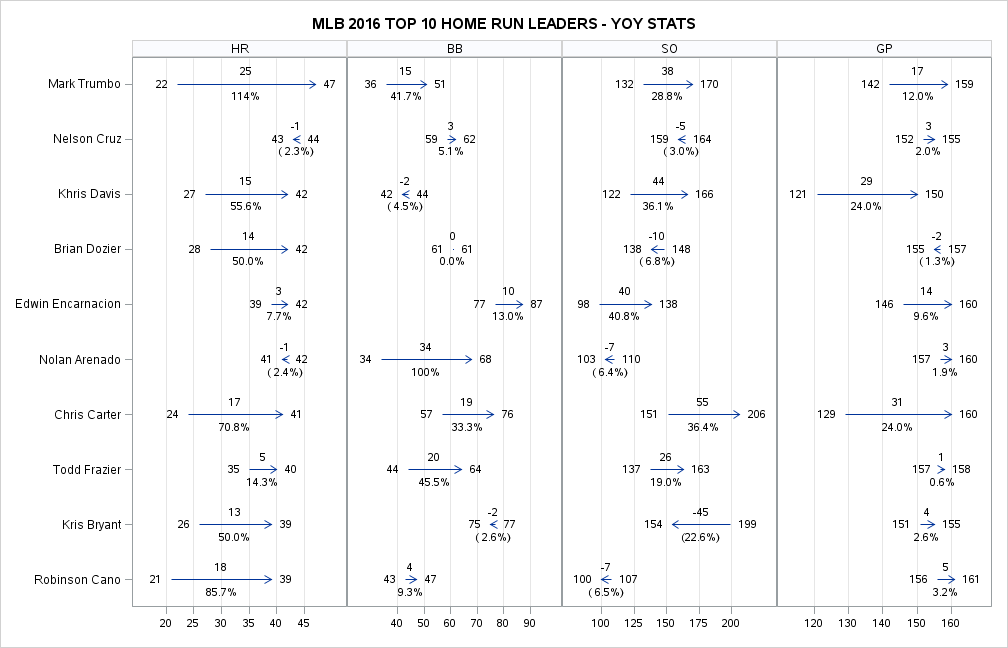- Home
- /
- Programming
- /
- Graphics
- /
- Fun w/SAS ODS Graphics: Ch-ch-ch-ch-Changes - Vector plots of YOY stat...
- RSS Feed
- Mark Topic as New
- Mark Topic as Read
- Float this Topic for Current User
- Bookmark
- Subscribe
- Mute
- Printer Friendly Page
- Mark as New
- Bookmark
- Subscribe
- Mute
- RSS Feed
- Permalink
- Report Inappropriate Content
SAS OUTPUT (VIEW LARGER IMAGE)
Was recently looking for ideas on how to display Ch-ch-ch-ch-Changes, so I reread Stephen Few's excellent Displaying Change Between Two Points in Time. Drawing inspiration from the Range Bar Graph and side-by-side combinations of graphs described therein, here's my chock-full-o'numbers SAS ODS Graphics vector plot look at selected year-over-year stats for Major League Baseball's Top 10 home run leaders of 2016.
SAS CODE
*-> Fun w/SAS ODS Graphics: Vector plots of YOY stats for MLB 2016 Top 10 home run leaders;
/* Data from espn.com (1 row per player/year */
proc import datafile='/folders/myfolders/2016MlbHrLeaders.xlsx' dbms=xlsx out=MlbHrLeaders2016 replace;
/* Transform to 1 row per player/stat */
proc transpose data=MlbHrLeaders2016 out=hrleaders prefix=X name=STAT;
by player notsorted; id year; var hr bb so gp;
data hrleaders; /* Add some calculated fields for plotting */
set hrleaders;
playernum=floor((_n_-1)/4)+1; /* 4 rows per player (1 for each stat) */
xlo=min(of x2015 x2016); /* Label for left side of vector */
xlotext=put(xlo,3.)||' '; /* Add some padding */
xhi=max(of x2015 x2016); /* Label for right side of vector */
xhitext=' '||compress(put(xhi,3.)); /* Add some padding */
chg=x2016-x2015; /* YOY change */
pctchg=(x2016-x2015)/x2015; /* YOY % change */
xmid=(xlo+xhi)/2; /* X coordinate for YOY change measures */
ymid1=playernum+.1; /* Y coordinate for YOY change (padding) */
ymid2=playernum-.1; /* Y coordinate for YOY percent change (padding) */
proc sql; /* Create format to print player name instead of # */
create table pfmt as select distinct 'pfmt' as fmtname, playernum as start, player as label from hrleaders;
proc format cntlin=pfmt;
ods graphics /reset height=6.75in width=10.5in; /* Time to plot! */
proc sgpanel data=hrleaders noautolegend; /* Panel by stat - homers, walks, strikeouts, games played */
panelby stat / onepanel rows=1 uniscale=row sort=data novarname headerattrs=(size=8pt);
title height=10pt "MLB 2016 TOP 10 HOME RUN LEADERS - YOY STATS";
vector x=x2016 y=playernum / xorigin=x2015 yorigin=playernum; /* Plot prior/current year stats */
text x=xlo y=playernum text=xlotext / position=left textattrs=(size=7.5pt);
text x=xhi y=playernum text=xhitext / position=right textattrs=(size=7.5pt);
text x=xmid y=ymid2 text=chg / position=top strip textattrs=(size=7pt); /* Plot YOY change */
text x=xmid y=ymid1 text=pctchg / position=bottom strip textattrs=(size=7pt); /* Plot YOY % change */
colaxis display=(nolabel) grid valueattrs=(size=7pt);
rowaxis display=(nolabel) values=(1 to 10 by 1) valueattrs=(size=8pt) offsetmin=.05 offsetmax=.05 reverse;
format playernum pfmt. chg 4. pctchg percent7.1 xlotext $char6.;
run;SCREENSHOT OF INPUT DATA (CUT-AND-PASTED FROM ESPN.COM)
- Mark as New
- Bookmark
- Subscribe
- Mute
- RSS Feed
- Permalink
- Report Inappropriate Content
Very interesting. I would suggest horizontal color bands on rowaxis to help differentiate the rows of data.
- Mark as New
- Bookmark
- Subscribe
- Mute
- RSS Feed
- Permalink
- Report Inappropriate Content
SAS OUTPUT (VIEW LARGER IMAGE)
Thanks, that does make a difference! Seems I can't use the nifty COLORBANDS= COLAXIS option here since my y-axis isn't DISCRETE, but a quick Google search turned up a SAS 9.3 tip from an old paper of yours that did the trick.
refline 1 3 5 7 9 / axis=y transparency=.85 lineattrs=(thickness=40pt color=green);
April 27 – 30 | Gaylord Texan | Grapevine, Texas
Registration is open
Walk in ready to learn. Walk out ready to deliver. This is the data and AI conference you can't afford to miss.
Register now and lock in 2025 pricing—just $495!
Learn how use the CAT functions in SAS to join values from multiple variables into a single value.
Find more tutorials on the SAS Users YouTube channel.
SAS Training: Just a Click Away
Ready to level-up your skills? Choose your own adventure.





